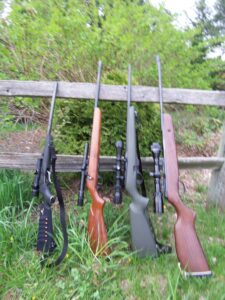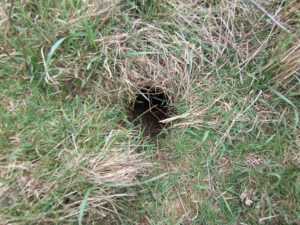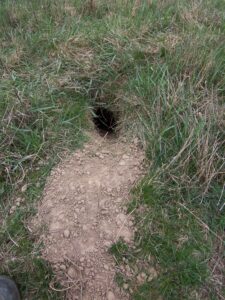My first hunting trip to Canada 40 years ago might surprise most folks. It wasn’t for moose or bear, but rather for that ground-dwelling rodent called a woodchuck. The area was rolling farm country interspersed with hardwoods and stone fences, and it gave you the impression that you were in New England, and not Ontario farm country on the Bruce Peninsula.
My three hunting companions were avid woodchuck hunters, who lived and breathed the pastime. When most hunters look upon spring/summer as an off-season period, it is the time when woodchuck hunters shine. The Ontario farmers were absolutely amazed by the fact that four Michigan men would travel all the way to their land to specifically hunt woodchucks. They were also absolutely delighted because the woodchuck population and the problems caused with their burrowing and crop raiding nature were at epidemic proportions. The key reason my companions had selected the location.
It wasn’t until we were uncasing our rifles at the first hunting site when I saw what these devoted woodchuck hunters used for shooting equipment. All 3 rifles were of the bolt-action persuasion, and 2 were chambered for .243 Winchester, and one was in the petite and venerable .22 Hornet which was developed many years ago with woodchuck hunting in mind. All 3 rifles featured custom-made stocks and long, high-powered scopes which reached nearly to rifle’s muzzle, and they were using their own hand-loaded ammunition.

Any rifle can make a ‘chuck rifle, including .22 rimfire rifles. The T/C Contender Carbine in .223 on the far left is used when more “reach” is required and the .17 caliber GAMO air rifle on the far right is used for a closer and more quiet approach near homes for requested nuisance control.
The rifle I was using was a single-shot Ruger Number One in.25-06 and topped with a 2-8X variable Leupold scope which I left on 8X due to the long ranges we were typically shooting. My hunting companions stressed long range shooting situations which left woodchucks often having no idea as to what was up.
They were real shooters too, as I watched one use his .243 to drop a sitting woodchuck, and then quickly rack in another round and drop a second, running woodchuck that had been grazing next to the first, at a range of 350 yards. The woodchuck hunter using the .22 Hornet rifle was usually given the opportunity to be the first to shoot at woodchucks which were a bit closer in. Even so, I was amazed at what he could still accomplish with this little cartridge, and with a lot less muzzle blast. I’ve been an ardent admirer of the old.22 Hornet cartridge ever since.
The .25-06 when loaded with a 90-grain hand-loaded bullet is one flat shooter, and it fits right into this environment. My most memorable shot occurred in a cow pasture where the landowner was in constant fear of broken-legged cattle due to the numerous woodchuck holes. When shooting with this seasoned trio of long-range shooters, it was only a measly 125 yards, and I was solidly braced over the trunk of a fallen maple tree. I took careful aim and touched the light trigger.
Much to my amazement, the woodchuck was still sitting on its haunches near its burrow, looking around for the cause of the explosion, and possibly wondering if a thunderstorm was about to happen, despite a clear blue sky. Then I heard the uncontrolled sound of laughter coming from the 3 observers leaning over the same fallen tree trunk. That is when I saw the bullet hole in the protruding tree branch six inches from the muzzle of my rifle. While my scope had a clear view over the branch, the bullet had come to a sudden stop.
Woodchuck hunters have an acute sense of humor for such occasions, and one of them conveniently produced a small pocket saw, and hewed-off the branch for me to take home as a trophy.
I was able to redeem myself in a newly sprouting soybean field that possessed a very visible quantity of grazing woodchucks. We were on a tall hilltop overlooking the field and I was in a prone firing position with the bipod-equipped Ruger, and I placed the crosshairs at the top of the woodchuck’s head as it was standing up on its hind legs for a sharp-eyed pan of its surroundings for danger. Even with my scope set at 8X, this was a small target at almost 400 yards, and I raised the crosshairs just a tad before firing, and lost view of my target during recoil.
Instead of laughter, I heard only compliments on a good shot but could tell it wasn’t anything spectacular the three woodchuck hunters hadn’t seen performed before. In fact, I got the feeling it was expected in their world. Of course, I don’t know who was more stunned by that shot, the unlucky woodchuck or me with probably a lucky shot.
I began hunting Thumb woodchucks on the family farm as a kid using a single-shot .22. The fact is, I still enjoy using .22 rimfire rifles for this pastime. Unlike my woodchuck-specialist companions on that Ontario woodchuck hunt, my rifles form multi-tasks when it comes to hunting in general. My favorite squirrel/rabbit rifles often come into play for summertime woodchucks. On top of that, I enjoy the art of spot and stalk and getting in as close as possible to my quarry, and wary woodchucks aren’t easy in this regard.
The rimfire .17’s (.17 Mach 2 and .17 HMR) has woodchuck hunting written all over them. The older .22 Winchester Magnum remains another rimfire jewel and is one of my favorites in the form of a vintage Ithaca lever-action, 10-shot repeater topped with a Weaver 1.5 x 5X variable scope.

Visible main entrance hole.
When the topography requires something with a little more reach, I often enjoy using my scoped T/C Contender Carbine in .223 and I have successfully accomplished shots near the 250-yard mark using shooting sticks for a solid brace. Not only binoculars, but range finders as well, are very helpful tools in this environment.
Ever since the Limited Firearms Zone in southern Michigan came about, I often use my (straight wall cartridge) deer rifles for ‘chuck hunting, as it is a great way to be fully acquainted with them well before deer season. Centerfire rifles in general have always been legal for “varmint” hunting in southern Michigan.

Woodchuck concealed “sneak hole” used for escape (usually more than one).
A friend of mine has a situation close to his home, where he has a literal woodchuck invasion taking place near his farm outbuildings, where they are really “digging in”, and the woodchucks have also literally destroyed his newly planted garden. To date this spring, he has killed over a dozen using a .22 rimfire rifle, as well as his shotgun with turkey loads, so anything that is close at hand when an opportunity presents itself can make a woodchuck gun in this instance. When tunneling woodchucks decide to move close to human habitations, they can be a real nuisance and become destructive on building foundations.
Hunting summertime woodchucks is certainly on my mind these days. At least in my neck of the woods, there are plenty around, and it is a great way to enjoy our great outdoors. And yep, folks, woodchucks are very edible as well, with a number of readily available recipes which can be found online.
- Fickle weather during December deer hunting adventures - December 3, 2025
- Michigan’s most popular opening day – November 15th - November 23, 2025
- A missing dog found while anticipating opening day - November 23, 2025

